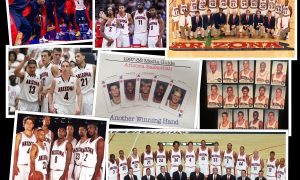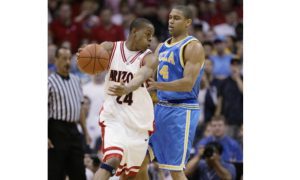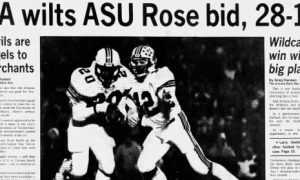|
|
|
ARIZONA PRODUCTIVITY RATING
[table “” not found /]
GLOSSARY:
G: Games played. S: Number of starts.
BP: Bench points. A player gets three points if he is first off the bench, two if second and one if third. Shows Sean Miller’s rotation.
UT: Productivity points against Utah
UMIN: Minutes played against Utah
PP: Productivity Points (Points, assists, rebounds, steals, blocked shots, FGs made, FTs made added together and then subtracted by missed FGs, missed FTs, personal fouls and turnovers)
TMIN: Minutes played overall
PR: Productivity rating per minute played (Productivity points divided by minutes played)
NOTE: Player must average at least 10 minutes a game to be listed in primary rotation
Ashley, benched in favor of the more experienced Parrom against Utah, responded by having the most productive game for the Wildcats. He produced 18 productivity points in 22 minutes, providing Arizona the spark it needed. Productivity points, published at this site, factor positive stats (made field goals, assists, etc.) subtracted by negative stats (missed field goals, turnovers, etc.).
“If I come off the bench and I only play five minutes a game, I’m still going to come in and show my best and impact the game in whatever ways I can, whether it’s scoring, rebounding or just playing defense,” Ashley was quoted by saying by the Associated Press after the game.
Parrom responded with his second start of the season by almost posting his first career double-double (nine rebounds and nine points in 29 minutes). The senior forward finished with 20 productivity points.
“We’re at the end of the road here,” Miller told the AP about starting Parrom. “He’s a senior and we’re going to ride the guys who have the most to gain and the most to lose. Lyons, Hill and Parrom – they’re the guys to me who can start the game the best way and start the second half the best way.”
They are among the nucleus of Wildcats who can also produce when called upon.
This is how balanced Arizona’s top five players stand: Hill leads the team with a .620 productivity rating (productivity points divided by minutes played) and Parrom is No. 5 at .587. Only 33 productivity rating points separate the top player from the No. 5 player. That’s uncommon. Seven different players have led the Wildcats in productivity rating in the 25 games. Ashley and Lyons have each topped the UA six times, Hill and Parrom four, and Johnson three.
This is a far cry the Derrick Williams-dominated Arizona team from only two years ago. The UA was fortunate he could play through a broken finger and carry it to an Elite Eight appearance.
Ashley also led a strong showing by a freshmen group that has played predictably unpredictable because of their youth. Ashley, starting center Kaleb Tarczewski and reserve forward Grant Jerrett combined for 41 productivity points in 52 minutes (a .788 rating) against Utah.
“Brandon was our best freshman today,” Miller told the AP. “He was our best frontcourt player today. Brandon answered the bell.
“For our team, it’s a matter of where we go from here. We are happy with the win but we have to get better as we move forward if we want to accomplish something special in March.”
Thanks to the 17 rebounds by Hill and Parrom the Wildcats won the rebounding battle 34-32. Utah center Jason Washburn had only seven after grabbing 11 last month in Utah’s loss at McKale Center.
Defensive Rebounding Percentage (DRB%): Determined by dividing Arizona’s defensive rebounds (23 against Utah) by the opposition’s offensive rebounds (Utah had 11) added to Arizona’s defensive rebounds (23) — 23/(11 + 23) = 67.6 percent.
Offensive Rebounding Percentage (ORB%): Determined by taking Arizona’s offensive rebound total (11) divided by that total (11) and the defensive rebounds of the opponent (21 for Utah) — 11/(11 + 21) = 34.4 percent.
Ideal marks are 72 percent DRB% and 38 percent ORB%.
|
DEFENSIVE/OFFENSIVE REBOUNDING% [table “” not found /] |
Site publisher, writer and editor Javier Morales is a former Arizona Press Club award winner
[rps-paypal]
|
|






























